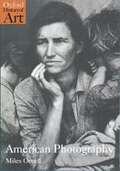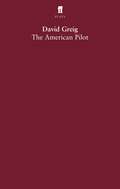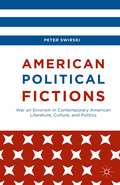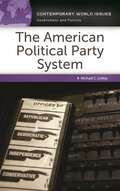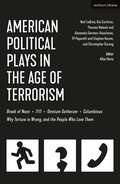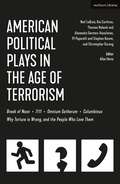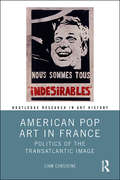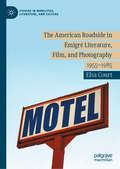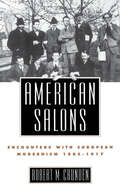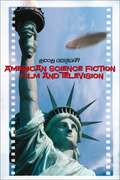- Table View
- List View
American Painting of the Nineteenth Century: Realism, Idealism, and the American Experience
by Barbara NovakIn this distinguished work, which Hilton Kramer in The New York Times Book Review called "surely the best book ever written on the subject," Barbara Novak illuminates what is essentially American about American art. She highlights not only those aspects that appear indigenously in our art works, but also those features that consistently reappear over time. Novak examines the paintings of Washington Allston, Thomas Cole, Asher B. Durand, Fitz H. Lane, William Sidney Mount, Winslow Homer, Thomas Eakins, and Albert Pinkham Ryder. She draws provocative and original conclusions about the role in American art of spiritualism and mathematics, conceptualism and the object, and Transcendentalism and the fact. She analyzes not only the paintings but nineteenth-century aesthetics as well, achieving a unique synthesis of art and literature. Now available with a new preface and an updated bibliography, this lavishly illustrated volume--featuring more than one hundred black-and-white illustrations and sixteen full-color plates--remains one of the seminal works in American art history.
American Photography: (pdf) (Oxford History Of Art Ser.)
by Miles Orvell150 years of American photography come alive in this exciting new book, placing it in its cultural context for the first time. Orvell examines this fascinating subject through a wide range of well known and less-well known images. He ranges from portraiture and landscape photography, family albums and memory, and analyses the particularly 'American' way in which American photographers have viewed the world around them. Orvell combines a clear overview of the changing nature of photographic thinking and practice in this period with an exploration of key concepts. The result is the first coherent history of American photography, which examines issues such as the nature of photographic exploitation, experimental techniques, the power of the photograph to shock, and whether we should subscribe to the notion of a visual history. ""What a terrific book!...Rich references to literature, history, art, and popular culture make this story come alive.""--Mary Panzer, Author of Matthew Brady and the Image of History, and former curator of photographs for the Smithsonian Institution's National Portrait Gallery
American Pickers Guide to Picking
by Libby CallawayA true adventure story and the go-to guide for "picking" American treasures from anyone's backyard, straight from the stars of History's American PickersIn these pages, professional treasure hunters Mike Wolfe and Frank Fritz chronicle their road trips across the American countryside in search of "rusty gold" to buy and sell among the picking world's one-of-a-kind characters. Whether you are a fan of the show or just like finding hidden riches, you will love seeing what Wolfe and Fritz dig up and enjoy meeting the devoted collectors, extreme stockpilers, and elite dealers who they encounter along the way.Wolfe and Fritz do not deal in fine antiques. Their secondhand treasures are of the down-and-dirty and sometimes even bizarre variety, from old bicycles and vintage tools, to sun-bleached cars and handmade furniture, retired carnival games and unusual taxidermy. Assisted by Danielle Colby, who helps out at Antique Archaeology, Wolfe and Fritz buy on the cheap and then sell to dealers, art directors, interior designers, or anyone looking for a little bit of authentic Americana. The three now share their secrets to finding hidden gems, offering helpful hints that will show what average Americans can do to find the treasures that await them.From American Pickers Guide to Picking:Junk is BeautifulWhen we knock on a door, 90 percent of the time the things we find are junk. But we don't care about the odds; a picker never turns down an opportunity, no matter where it is. We've picked pickup trucks. We've picked flat beds. We've picked dumpsters. We even picked a Mercury Sable. We're looking for the unusual, the impossible, the funky, the different, the bizarre-things we have never seen before. And we'll go anywhere we have to go to find it.No location is off-limits to a hard-core picker. And there's plenty of things to be found at antique stores, thrift and consignment shops, flea markets, estate sales, and swap meets, and a lot of the tips in this book apply to finding treasures at these joints. But that's not really the kind of picking we do anymore. We look outside the box to find our junk-a word we use almost like a term of endearment: to us: junk is beautiful.
American Pickers Guide to Picking
by Libby CallawayA true adventure story and the go-to guide for "picking" American treasures from anyone's backyard, straight from the stars of History's American Pickers In these pages, professional treasure hunters Mike Wolfe and Frank Fritz chronicle their road trips across the American countryside in search of "rusty gold" to buy and sell among the picking world's one-of-a-kind characters. Whether you are a fan of the show or just like finding hidden riches, you will love seeing what Wolfe and Fritz dig up and enjoy meeting the devoted collectors, extreme stockpilers, and elite dealers who they encounter along the way. Wolfe and Fritz do not deal in fine antiques. Their secondhand treasures are of the down-and-dirty and sometimes even bizarre variety, from old bicycles and vintage tools, to sun-bleached cars and handmade furniture, retired carnival games and unusual taxidermy. Assisted by Danielle Colby, who helps out at Antique Archaeology, Wolfe and Fritz buy on the cheap and then sell to dealers, art directors, interior designers, or anyone looking for a little bit of authentic Americana. The three now share their secrets to finding hidden gems, offering helpful hints that will show what average Americans can do to find the treasures that await them.From American Pickers Guide to Picking:Junk is Beautiful When we knock on a door, 90 percent of the time the things we find are junk. But we don't care about the odds; a picker never turns down an opportunity, no matter where it is. We've picked pickup trucks. We've picked flat beds. We've picked dumpsters. We even picked a Mercury Sable. We're looking for the unusual, the impossible, the funky, the different, the bizarre-things we have never seen before. And we'll go anywhere we have to go to find it. No location is off-limits to a hard-core picker. And there's plenty of things to be found at antique stores, thrift and consignment shops, flea markets, estate sales, and swap meets, and a lot of the tips in this book apply to finding treasures at these joints. But that's not really the kind of picking we do anymore. We look outside the box to find our junk-a word we use almost like a term of endearment: to us: junk is beautiful.
The American Pilot: Outlying Island - San Diego - The American Pilot - Pyrenees - Kyoto - Being Norwegian
by David GreigA spy plane crash-lands in a remote valley in a distant country. The local villagers take in the wounded pilot and argue his fate. The American Pilot explores the way the world sees America and the way America sees the world.The American Pilot premiered with the RSC at The Other Place, Stratford-upon-Avon in April 2005.'Greig at his best.' Evening Standard.'One of the most intellectually stimulating dramatists around... A richly provocative new play.' Guardian'The sheer brilliance of Greig, storyteller and seer.' Herald.The American Pilot premiered with the RSC at The Other Place, Stratford Upon Avon, in April 2005.
American Playwriting and the Anti-Political Prejudice: Twentieth- and Twenty-First-Century Perspectives (Palgrave Studies in Theatre and Performance History)
by N. PressleyTwenty years after Tony Kushner's influential Angels in America seemed to declare a revitalized potency for the popular political play, there is a "No Politics" prejudice undermining US production and writing. This book explores the largely unrecognized cultural patterns that discourage political playwriting on the contemporary American stage.
American Political Fictions: War on Errorism in Contemporary American Literature, Culture, and Politics
by Peter SwirskiThrough a discussion of diverse art and media such as apocalyptic thrillers, rap, and television, Swirski debunks the American political system, sieving out fact from a sea of bipartisan untruths. Engaging with close analysis and multiple case studies, this book forges a more accurate picture of contemporary American culture and of America itself.
The American Political Party System: A Reference Handbook (Contemporary World Issues)
by Michael C. LeMayWhat historical factors transformed American politics into the institution we know today? This in-depth look at America's party system traces its efficacy, sustainability, and popularity through six influential presidencies spanning 1790 to the present day.Did President Obama's election serve as the impetus to the development of a seventh political party system? This compelling text sheds light on the American political process as seen through the lens of six pivotal presidencies that shaped America's culture, politics, and society and considers how our current president may be the latest transformative leader in this lineage. Covering two centuries of politics, the work offers insight into the American political machine and reveals how and why the two-party system became so dominant in American politics. Topics include the media's focus on the horse-race aspect of elections, the declining importance of party identification, and the impact of the geographical split that results in swing-states and gerrymandered districts.The work begins by dividing 200 years of politics into 6 periods influenced by a transformative president and discussing the profile of the party system in each era. The next section presents essays contributed by activists across a myriad of political parties and profiles leading political actors and organizations. The final section includes tables, primary source documents, reference lists, a detailed glossary, and a timeline of the development of American political parties that help elucidate the text and show the role political parties have played throughout history.
The American Political Party System: A Reference Handbook (Contemporary World Issues)
by Michael C. LeMayWhat historical factors transformed American politics into the institution we know today? This in-depth look at America's party system traces its efficacy, sustainability, and popularity through six influential presidencies spanning 1790 to the present day.Did President Obama's election serve as the impetus to the development of a seventh political party system? This compelling text sheds light on the American political process as seen through the lens of six pivotal presidencies that shaped America's culture, politics, and society and considers how our current president may be the latest transformative leader in this lineage. Covering two centuries of politics, the work offers insight into the American political machine and reveals how and why the two-party system became so dominant in American politics. Topics include the media's focus on the horse-race aspect of elections, the declining importance of party identification, and the impact of the geographical split that results in swing-states and gerrymandered districts.The work begins by dividing 200 years of politics into 6 periods influenced by a transformative president and discussing the profile of the party system in each era. The next section presents essays contributed by activists across a myriad of political parties and profiles leading political actors and organizations. The final section includes tables, primary source documents, reference lists, a detailed glossary, and a timeline of the development of American political parties that help elucidate the text and show the role political parties have played throughout history.
American Political Plays in the Age of Terrorism: Break of Noon; 7/11; Omnium Gatherum; Columbinus; Why Torture is Wrong, and the People Who Love Them
by Neil LaBute Kia Corthron Theresa Rebeck Alexandra Gersten-Vassilaros Stephen Karam PJ Paparelli Christopher DurangThis powerful anthology brings together reflective and raw plays by American playwrights surrounding the psychic and political boundaries of the many faces and shadows of terrorism. Allan Havis's introduction addresses a variety of terrorism cases from the last 25 years, examines several theories of the root causes of modern terrors, and underscores how theatre forms a unique contour to social and philosophical thought on terrorism. With a foreword from Robert Brustein, the anthology features: Break of Noon by Neil LaBute7/11 by Kia CorthronOmnium Gatherum by Theresa Rebeck and Alexandra Gersten-VassilarosColumbinus by PJ Paparelli and Stephen KaramWhy Torture is Wrong, and the People Who Love Them by Christopher Durang
American Political Plays in the Age of Terrorism: Break of Noon; 7/11; Omnium Gatherum; Columbinus; Why Torture is Wrong, and the People Who Love Them
by Neil LaBute Kia Corthron Theresa Rebeck Alexandra Gersten-Vassilaros Stephen Karam PJ Paparelli Christopher DurangThis powerful anthology brings together reflective and raw plays by American playwrights surrounding the psychic and political boundaries of the many faces and shadows of terrorism. Allan Havis's introduction addresses a variety of terrorism cases from the last 25 years, examines several theories of the root causes of modern terrors, and underscores how theatre forms a unique contour to social and philosophical thought on terrorism. With a foreword from Robert Brustein, the anthology features: Break of Noon by Neil LaBute7/11 by Kia CorthronOmnium Gatherum by Theresa Rebeck and Alexandra Gersten-VassilarosColumbinus by PJ Paparelli and Stephen KaramWhy Torture is Wrong, and the People Who Love Them by Christopher Durang
American Politics in Hollywood Film
by Ian ScottHow is the American political landscape represented in cinema? What is the relationship between Hollywood and Washington? From Arnold Schwarzenegger's rise to the Governorship of California through to the drama of the celebrity-fuelled 2008 Presidential election, Hollywood and politics have never been more intimate.This thoroughly updated and revised new edition continues to analyse the theoretical and conceptual relationship of Hollywood to national politics and the way film content and criticism has aligned itself to political culture and debate.Chronicling the evolution of American political cinema from the 1930s, this book explores the genre's symbiotic relationship with the American political culture and history. Through textual analysis of a range of films and television series, Scott provides a critique of current and past developments across several sub-genres, including the bio-pic, the election film and documentary.
American Politics in Hollywood Film (Edinburgh University Press)
by Ian ScottIn this second edition of American Politics in Hollywood Film, Ian Scott takes up his analysis of political content and ideology through movies and contends that American culture and the institutional process continues to be portrayed, debated and influenced by a whole series of films.
American Pop Art in France: Politics of the Transatlantic Image (Routledge Research in Art History)
by Liam ConsidinePop art was essential to the Americanization of global art in the 1960s, yet it engendered resistance and adaptation abroad in equal measure, especially in Paris. From the end of the Algerian War of Independence and the opening of Ileana Sonnabend’s gallery for American Pop art in Paris in 1962, to the silkscreen poster workshops of May ’68, this book examines critical adaptations of Pop motifs and pictorial devices across French painting, graphic design, cinema and protest aesthetics. Liam Considine argues that the transatlantic dispersion of Pop art gave rise to a new politics of the image that challenged Americanization and prefigured the critiques and contradictions of May ’68.
American Pop Art in France: Politics of the Transatlantic Image (Routledge Research in Art History)
by Liam ConsidinePop art was essential to the Americanization of global art in the 1960s, yet it engendered resistance and adaptation abroad in equal measure, especially in Paris. From the end of the Algerian War of Independence and the opening of Ileana Sonnabend’s gallery for American Pop art in Paris in 1962, to the silkscreen poster workshops of May ’68, this book examines critical adaptations of Pop motifs and pictorial devices across French painting, graphic design, cinema and protest aesthetics. Liam Considine argues that the transatlantic dispersion of Pop art gave rise to a new politics of the image that challenged Americanization and prefigured the critiques and contradictions of May ’68.
American Postfeminist Cinema: Women, Romance and Contemporary Culture (Traditions in American Cinema)
by Michele SchreiberAmerican Postfeminist Cinema is the first book to examine the symbiotic relationship between heterosexual romance and postfeminist culture.
American Progress: Nerdkultur, akrobatische Komik und Commedia dell'arte (Serienkulturen: Analyse – Kritik – Bedeutung)
by Holger SchulzeDie Serie 30Rock wälzt die medialen Erzählungen ihrer Epoche (und der Serie selbst) unaufhörlich um: in bislang sieben Staffeln, 140 Episoden, von 30 Autoren für 14 SchauspielerInnen geschrieben – rund um die Erfinderin und Hauptdarstellerin Tina Fey. Dieser Band untersucht die überdrehte Gegenwartsdystopie, ihre Erzählungen, Bühnen und Personen. Markante Episoden werden im Zusammenhang zeitgenössischer Pop- und TV-Kultur untersucht und einzelne ProtagonistInnen in ihrem medialen Handeln und dessen Referenzen. Ein Tableau der Medien- und der Nerdkultur sowie der politischen Agitation entsteht in Form von akrobatischer Komik und Celebrityobsession: eine Form der Commedia dell'arte über den American Progress.
American Protestants and TV in the 1950s: Responses to a New Medium (Religion/Culture/Critique)
by M. RosenthalAmericans in the 1950s faced the challenge of negotiating the new medium's place in the home and in American culture in general. Using the American Protestant experience of the introduction of television, Rosenthal illustrates the importance of the interplay between a new medium and its users.
American Puppet Modernism: Essays on the Material World in Performance (Palgrave Studies in Theatre and Performance History)
by John BellPlease note this is a 'Palgrave to Order' title (PTO). Stock of this book requires shipment from an overseas supplier. It will be delivered to you within 12 weeks. This study analyses the history of puppet, mask, and performing object theatre in the United States over the past 150 years to understand how a peculiarly American mixture of global cultures, commercial theatre, modern-art idealism, and mechanical innovation reinvented the ancient art of puppetry.
American Revenge Narratives: A Collection of Critical Essays
by Kyle WigginsAmerican Revenge Narratives critically examines the nation’s vengeful storytelling tradition. With essays on late twentieth and twenty-first century fiction, film, and television, it maps the coordinates of the revenge genre’s contemporary reinvention across American culture. By surveying American revenge narratives, this book measures how contemporary payback plots appraise the nation’s political, social, and economic inequities. The volume’s essays collectively make the case that retribution is a defining theme of post-war American culture and an artistic vehicle for critique. In another sense, this book presents a scholarly coming to terms with the nation’s love for vengeance. By investigating recent iterations of an ancient genre, contributors explore how the revenge narrative evolves and thrives within American literary and filmic imagination. Taken together, the book’s diverse chapters attempt to understand American culture’s seemingly inexhaustible production of vengeful tales.
The American Roadside in Émigré Literature, Film, and Photography: 1955–1985 (Studies in Mobilities, Literature, and Culture)
by Elsa CourtThe American Roadside in Émigré Literature, Film, and Photography: 1955–1985 traces the origin of a postmodern iconography of mobile consumption equating roadside America with an authentic experience of the United States through the postwar road narrative, a narrative which, Elsa Court argues, has been shaped by and through white male émigré narratives of the American road, in both literature and visual culture. While stressing that these narratives are limited in their understanding of the processes of exclusion and unequal flux in experiences of modern automobility, the book works through four case studies in the American works of European-born authors Vladimir Nabokov, Robert Frank, Alfred Hitchcock, and Wim Wenders to unveil an early phenomenology of the postwar American highway, one that anticipates the works of late-twentieth-century spatial theorists Jean Baudrillard, Michel Foucault, and Marc Augé and sketches a postmodern aesthetic of western mobility and consumption that has become synonymous with contemporary America.
American Salons: Encounters with European Modernism, 1885-1917
by Robert M. CrundenIn American Salons, Robert Crunden provides a sweeping account of the American encounter with European Modernism up to the American entry into World War I. Crunden begins with deft portraits of the figures who were central to the birth of Modernism, including James Whistler, the eccentric expatriate American painter who became the archetypal artist in his dress and behavior, and Henry and William James, who broke new ground in the genre of the novel and in psychology, influencing an international audience in a broad range of fields. At the heart of the book are the American salons--the intimate, personal gatherings of artists and intellectuals where Modernism flourished. In Chicago, Floyd Dell and Margery Currey spread new ideas to Sherwood Anderson, Theodore Dreiser, and others. In London, Ezra Pound could be found behind everything from the cigars of W. B. Yeats to the prose of Ford Madox Hueffer. In Paris, the salons of Leo and Gertrude Stein, and Michael and Sarah Stein, gave Picasso and Matisse their first secure audiences and incomes; meanwhile, Gertrude Stein produced a new writing style that had an incalculable impact on the generation of Ernest Hemingway. Most important of all were the salons of New York City. Alfred Stieglitz pioneered new forms of photography at the famous 291 Gallery. Mabel Dodge brought together modernist playwrights and painters, introducing them to political reformers and radicals. At the salon of Walter and Louise Arensberg, Marcel Duchamp and Francis Picabia rubbed shoulders with Wallace Stevens, Man Ray, and William Carlos Williams. By 1917, no art in America remained untouched by these new institutions. From the journalism of H. L. Mencken to the famous 1913 Armory Show in New York, Crunden illuminates this pivotal era, offering perceptive insights and evocative descriptions of the central personalities of Modernism.
American Science Fiction and the Cold War: Literature and Film
by David SeedFirst Published in 1999. Routledge is an imprint of Taylor & Francis, an informa company.
American Science Fiction and the Cold War: Literature and Film (America In The 20th/21st Century Ser. #Vol. 3)
by David SeedFirst Published in 1999. Routledge is an imprint of Taylor & Francis, an informa company.
American Science Fiction Film and Television
by Lincoln GeraghtyAmerican Science Fiction Film and Television presents a critical history of late 20th Century SF together with an analysis of the cultural and thematic concerns of this popular genre. Science fiction film and television were initially inspired by the classic literature of HG Wells and Jules Verne. The potential and fears born with the Atomic age fuelled the popularity of the genre, upping the stakes for both technology and apocalypse. From the Cold War through to America's current War on Terror, science fiction has proved a subtle vehicle for the hopes, fears and preoccupations of a nation at war.The definitive introduction to American science fiction, this is also the first study to analyse SF across both film and TV. Throughout, the discussion is illustrated with critical case studies of key films and television series, including The Day the Earth Stood Still, Planet of the Apes, Star Trek: The Next Generation, The X-Files, and Battlestar Galactica.

